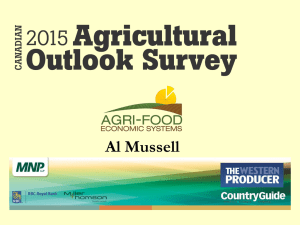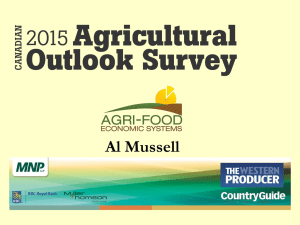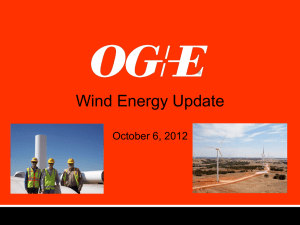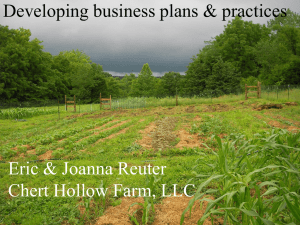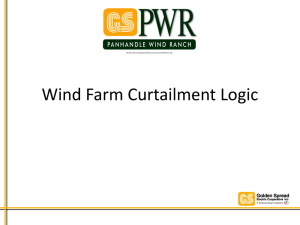Course Artifact
advertisement
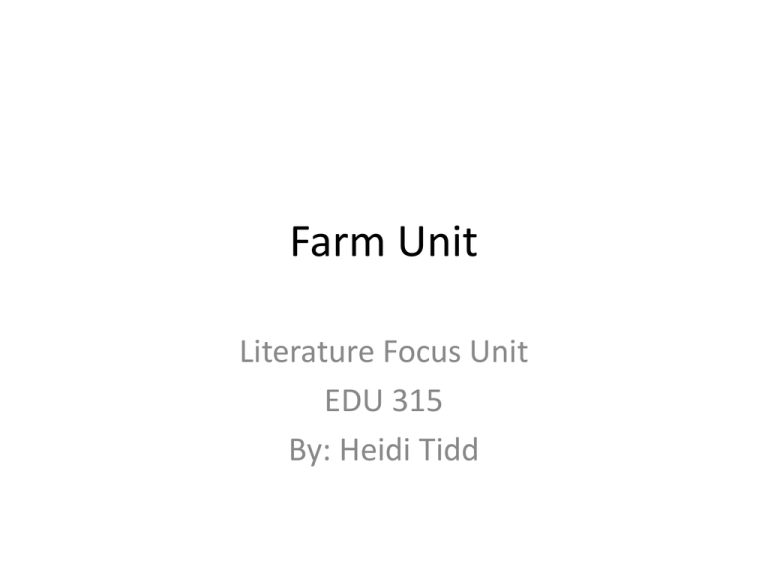
Farm Unit Literature Focus Unit EDU 315 By: Heidi Tidd Literature Selection • • • • • • • • • • • • Brown Bear, Brown Bear, What do you see? By Bill Martin Jr./Eric Carle Polar Bear, Polar Bear, What do you hear? By Bill Martin Jr./Eric Carle I Went Walking By Sue Williams Click-Clack-Moo Cows That Type by Doreen Cronin In the Sheep Pasture by Patricia M. Stockland Working On A Farm by Katie Marsico In the Pig Pen by Patricia M. Stockland On the Farm by Annnabelle Garges Senses on the Farm by Shelley Rotner Farm Machines by Jim Pipe Johnny Tractor and the Big Surprise by Judy Katschke Farm Animals by Melvin and Gilda Berger Theme Study • Students will be taking a part in a thematic unit on farm life/living. This unit will integrate reading and writing with social studies, science, mathematics, art, music and physical education. • Students will have an understanding about farm animals, farm jobs, and farm life. Language Arts: Reading Activities • Teacher will read aloud the book Brown Bear, Brown Bear. • Students will read in groups the books by Patricia M. Stockland. • Teacher will read working on the Working On A Farm by Katie Marsico. • Students will read their poems, stories and book page. • Students will read Senses on the Farm by Shelley Rotner. • Teacher will read Johnny Tractor and the Big Surprise by Judy Katschke. Language Arts: Writing Activities • Students will make an ongoing learning journal what they learned about farming. • Students will write their own page of Black Cow, Black Cow, What Do You Hear? • Students will write a “what is it poem?” About farming. • Students will write a story about a farm animal. • Students will create a what do you see on the farm booklet. Language Arts: Speaking Activities • Student will share the Black Cow page from the book on a farm animal. • Students will use the author’s chair to read their what is it poem. • Students will talk about all the things they know about a farm and what they learned on the farm. • Students will share their animal stories in the author’s chair. • Students will talk in small groups what they want to learn about a farm. Language Arts: Listening Activities • Students will listening to Farm animals noises and repeating them. • Students will listen respectfully to each others poems, animals page and farm story. • Student will listen to A Day At The Farm With Farmer Jason by Farmer Jason. • Students will listen to Brown Bear, Brown Bear, What Do You Hear? By Bill Martin Jr./Eric Carle. • Students will listen to the farmer on the farm field trip. Language Arts: Viewing Activities • Students will create KWL – on chart paper, what do you know about farm animals. • Students will view different pictures of animals. • Students will view the Farm Word Wall. • Students will take a trip to a farm. • Student will see a toy farm and talk about what they see, what they think is missing. Language Arts: Visually Representing Activities • Students will create an Animal wall of big and little animals. • Students will create a Farm Word Wall. • Students will showing mama animals vs. baby animals. • Students will display their poem with an animal painting. • Students will create a life cycle with animal picture and words. Science Activities: • Student will be learning the life cycle of an animal. • Students will learn animal groups on the Farm or at the Zoo. • Students will learn the different animal names (cow vs. calf). • Students will talk about and make a table the different jobs of a farmer throughout the seasons. • Students will learn how to milk a cow. By watching a video on how to milk a cow. Mathematics Activities • Students will take a survey of how many farm animals you know before the unit and how many you can think of after the unit, put them in a graph. • Students will compare large and small farm animals. • Students will measure each other compared to a cow. • Students will talk about money and the price of the farm animals. Learn has it gone up or down, keep it in a journal. Listen to an auction sale of animals. • Students will measure how much their plant grew and recorder and later graph its change. Social Studies Activities • Students will learn about farming – tools and machinery that we use now and a long time ago. • Teacher will read the book Farm Machines by Jim Pipe to learn about what is used now. • Student will use a web site to see technology. • Students will learn about farming in different countries. Teacher will draw up on a map different places different crops grow. • Students will learn about planting seeds and grow their own plants in class. Music and Art Activities • Student will make a soap carving of an animal. • Students will paint a picture of the animal from the what is it poem. • Students will create muddy pigs with construction paper and brown paint. • Students will create fluffy sheep with paint and cotton balls. • Students will sing the song Old MacDonald Had a Farm and At The Farm by Twin Sisters. • Students will create animal masks. Physical Education Activities • Students will do animal yoga – using kids yoga. • Students will make animal motions around the room while making noises. • Students will jump, skip, hop stop and spell their spelling words. • Students will spend a day walking around a farm. • Students will play musical animals. • Students will play rodeo round up. • Students will play Simon says being certain farm animals Technology • For the life cycle: http://chickscope.beckman.uiuc.edu/explore/ embryology/ • History of farm machinery: http://www.youtube.com/watch?v=d9_qJwwL qsU&feature=related • Virtual Farm: www.sites.ext.vt.edu/virtualfarm • Babe the DVD • Charlotte's Web the DVD Language Arts Strategies • Activating background knowledge: students will talk about what they already know about farming and farm life. • Connecting: Students will be relating to farming with their own world. • Playing with language: Students will use language to create poems, stories and a page for the book. • Visualizing: Students will create a farm life in their minds. • Monitoring: Students will be tracking the growth of their plants and tracking money. Language Arts Skills • Print: Students will be able to recognize words on the Farm Word Wall. • Comprehension: Students will recognize different characteristics of animals. Students will have a basic understanding of poetry. • Language: Students will apply various skills in their writing activities: poem, journal and farm stories. • Reference: Students will make a t-table, Farm word wall, and a money chart. Grouping Patterns • Large group: conversation about jobs of a farmer, charting number farm animals, visit a farm, KWL chart, life cycle of an animal, animal yoga, singing songs, word wall, announce animal price. • Small group: talk about KWL, animals on farm or zoo, ideas for book page, camouflage, life cycle of an animal, animal sizes, small group discussions, farming tools, measure plants, and make a graph from plant measuring. • Individual group: Poems, book page, journal entries, farm animal story, paintings, carvings, farm animal list, animal masks, record plant measuring, and create graph in learning notebook. Assessments • Journal entries of animals and the KWL chart: check list for dates, tracking money and tracking plants. • Participation in group dissuasions. • Poems, stories and book page: checklist, 6+1 writing traits. • Observation when reading their poem, farm story, and book page. • Math: graphing and measuring: observation and checklist. • Spelling is right when using word from the word wall. • Portfolio of work: poem, painted animal, and farm story. • Active participation in music and physical education. • Social studies: being able to know new and old farming methods. (Reports)

